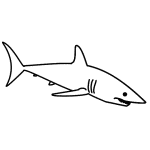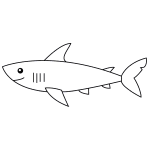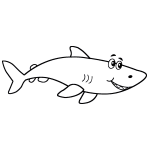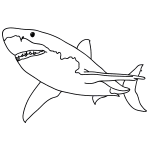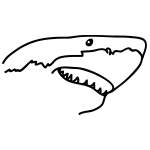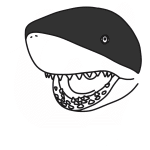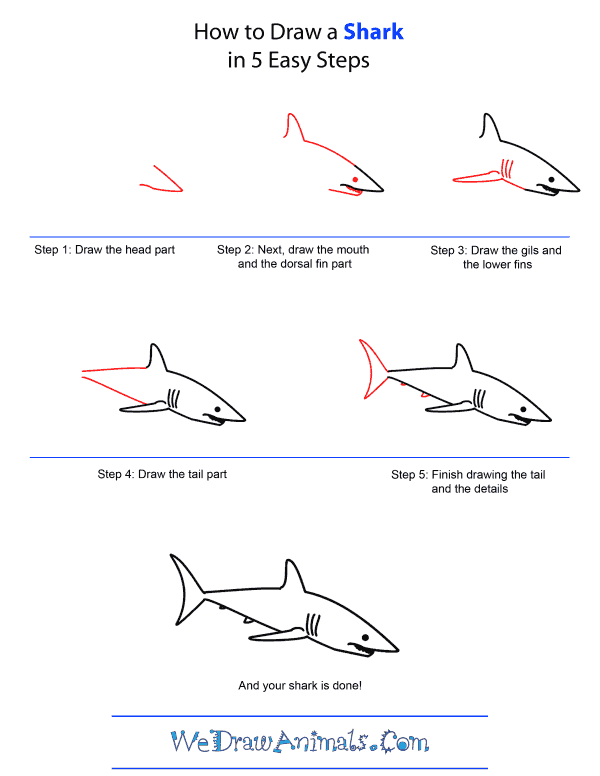In this quick tutorial you'll learn how to draw a Shark in 5 easy steps - great for kids and novice artists.
The images above represent how your finished drawing is going to look and the steps involved.
Below are the individual steps - you can click on each one for a High Resolution printable PDF version.
At the bottom you can read some interesting facts about the Shark.
Make sure you also check out any of the hundreds of drawing tutorials grouped by category.
How to Draw a Shark - Step-by-Step Tutorial
Step 1: First draw a very pointy snout. Think of a letter "V" on its side.
Step 2: In the middle of the snout add a tiny eye. Draw another thin triangle along the bottom of the snout. This makes the bottom jaw. Now draw a long curved line for the back. At the end of the back line draw the triangle shaped dorsal fin at the top.
Step 3: Next draw the thin lower pointy fin along the bottom below the top fin. Now add the gills right in front of the lower fin. Make sure the gill lines go up and down.
Step 4: Continue the back line and the belly line. They narrow towards each other at the end.
Step 5: Complete these lines by drawing the triangular tail. Make the top and bottom points very sharp and pointy. Curve the line between the tips. Add two more tiny fins along the bottom between the tail and the bottom fin.
Interesting Facts about Sharks
Sharks are a group of fish among thousands that live within our waters. The oldest species of shark lived over 420 million years ago and were very different than modern sharks. They were much smaller, with a much weaker jaw joint and were mostly scale-less, unlike modern sharks.
Today there are over 400 species of sharks, whose beginnings date back 100 million years. These sharks can be as small as 6.7 inches in length, like the dwarf lantern shark, to about 39 feet, such as the whale shark, which is the largest fish in the world.
The size, shape and sharpness of a shark’s teeth are related to what it eats. Sharks that feed on hard-shelled aquatic life have flat, thick teeth that grow close together so they can crush shells. Sharks that eat other fish have teeth like needles for gripping and sharks that feed on mammals, such as seals and dolphins, have angled upper teeth with sharp, jagged edges and bottom teeth that are pointed, which are good for gripping and tearing.
Did you know?
- A shark skeleton consists of flexible cartilage, rather than bone.
- Shark teeth grow in rows along their gums and they will shed and re-grow tens of thousands of teeth over their lifetime
- Sharks have a system of sensory organs in their heads that can detect electromagnetic fields that come from all living things. They have the strongest system for detecting electric fields of all animals, which helps them find their prey.
- While most sharks live for 20-30 years, one shark, the spiny dog fish shark can live for more than 100 years.
- The fastest shark is the shortfin mako shark, which is also the fastest fish over all. It can swim in bursts of 50 miles per hour.
- Most sharks live in the sea, but the bull shark and river shark can also live in freshwater.
While sharks, as a whole, are thought to be extremely dangerous, only four of all species of shark, the great white, oceanic whitetip, tiger, and bull sharks have fatally attacked humans with no reason at all. These sharks are very large and powerful predators, while most sharks pose no threat if they aren’t scared or provoked.

